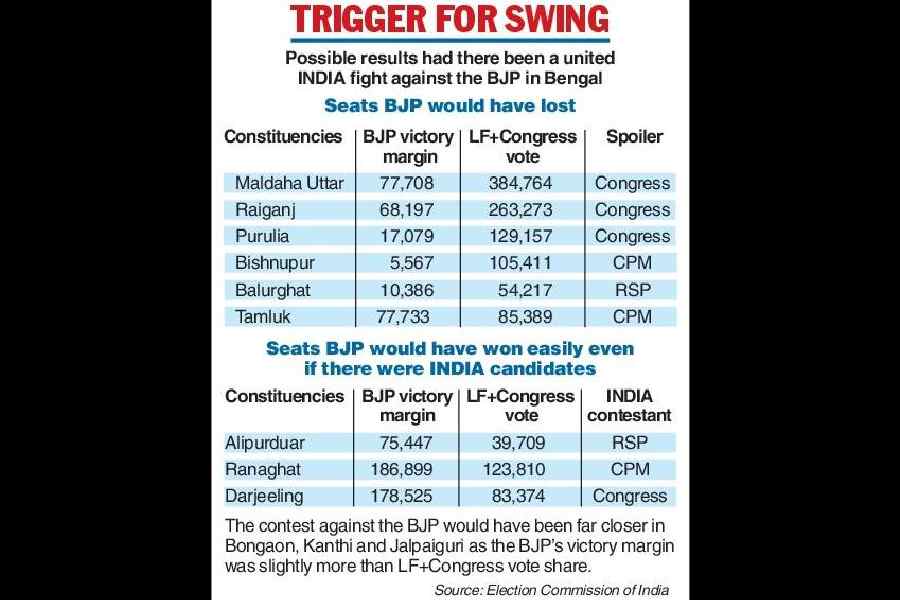A united fight by the INDIA bloc in Bengal would have cost the BJP at least six Lok Sabha seats out of the 12 it won in the state, an analysis of poll data by this newspaper suggests.
All these six seats — Maldaha Uttar, Raiganj, Purulia, Bishnupur, Balurghat and Tamluk — would then have gone to the Trinamool Congress. The BJP’s victory margin over Bengal’s ruling party in these seats was less than the votes polled by the Left-Congress combine.
Also, a united INDIA could have set up close contests in Bongaon, Jalpaiguri and
Kanthi, where the BJP’s victory margin over Trinamool was marginally more than the Left-Congress vote. Indeed, a united Opposition could potentially have swung the popular mood in favour of the INDIA bloc in these three seats.
A united fight against the BJP in Bengal, as in the rest of the country, had looked possible till the first two meetings of the INDIA bloc, held in Patna and Bangalore in June and July last year, respectively.
Eventually, what Mamata Banerjee deemed an “inordinate delay” in finalising seat shares — and her reservations about the CPM and state Congress chief Adhir Chowdhury — prompted her to announce in January that Trinamool would go it alone in Bengal.
The Congress, after several rounds of failed talks with Trinamool, stitched a half-hearted seat-sharing formula with the Left close to the elections.
Trinamool bagged 29 of Bengal’s 42 Lok Sabha seats while the BJP won 12 and the Left-Congress alliance had to be content with only one.
This newspaper’s analysis of the likely outcome had the INDIA partners fought together, based on Election Commission data, has been done assuming the voting patterns would have remained the same in such a bipolar contest.

Thus extrapolated, the data show that in case of a united fight against the BJP, the final tallies could have looked distinctively different (See chart).
The BJP might have had comfortable victories in only three seats: Alipurduar, Ranaghat and Darjeeling.
Bongaon, Kanthi and Jalpaiguri (won by the BJP) might have witnessed cliff-hangers.
The BJP might have lost in Maldaha Uttar, Raiganj, Purulia, Bishnupur, Balurghat and Tamluk.
The analysis also throws up several facts about the vote and seat shares that can provide a better understanding of the changing political landscape in Bengal.
Multiple sources in Trinamool had contended that Mamata’s decision to go it alone was also driven by an understanding that a three-cornered fight might end up helping her by splitting anti-Trinamool votes.
The poll data contest this hypothesis.
The BJP’s vote share of 38.7 per cent, while lower than the 40.2 per cent it had polled in 2019 when it bagged 18 Lok Sabha seats in Bengal, is higher than the 37.9 per cent it tallied in the 2021 Assembly elections.
In contrast, Trinamool’s vote share fell by about 2 percentage points from the 48 per cent it polled in 2021. Although the party can claim that it fared better than 2019 when it polled 43.3 per cent, it can’t be overlooked that it led from 192 Assembly seats this time compared with the 215 it won three years ago.
Trinamool’s poll strategists might argue that general elections are intrinsically different from Assembly polls, but the Lok Sabha poll numbers suggest that the BJP’s performance — both in terms of vote and Assembly seat shares — is on the ascendance.
Therefore, while the BJP may be on the back foot after its latest Bengal debacle, it cannot be written off in the context of future elections given the party’s keen desire to wrest control of the border state and the lengths of divisive politics it can pursue to achieve its end.
With Trinamool losing in several seats because of strong performances by the Left-Congress, Mamata has accused the combine of “dividing the secular vote” to facilitate the BJP’s victory — her stand belying the “split in anti-Trinamool votes” theory.
The state Congress has, on the other hand, blamed her offer of “only two seats” to possible INDIA partners for the failure to put up a united fight.
The collective euphoria in the Opposition camp over the BJP’s failure to achieve a majority on its own may defer a discussion on why a united fight — even a seat-sharing “arrangement” — eluded it in Bengal.
There is, however, little doubt that the Opposition parties need to bury their differences and jointly take on Modi, who may be down for the moment but not knocked out of reckoning for the future.











